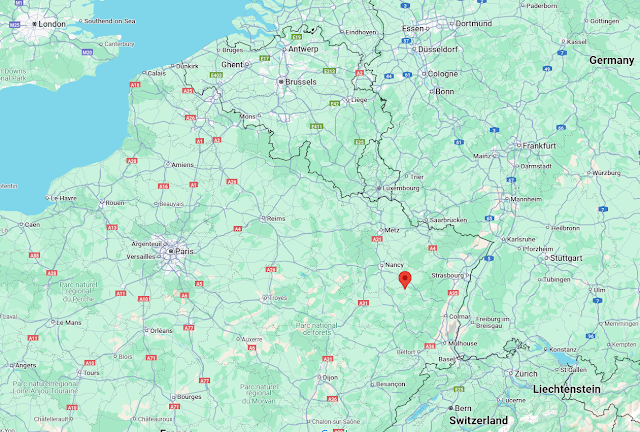Hugh Nicol Ritchie
Hugh Nicol Ritchie was born on 26th September 1898 at a street then called Park Road South, Whiteinch. The clue is in the name, of course and this street is now called Victoria Park Road South:
Unfortunately as the streets were renamed they also seem to have been renumbered because while Hugh was born at number 70, the modern street has only odd numbers. The map above is from 1894 so within four years of Hugh's birth, so we there is a reasonable chance it was in one of the four blocks shown fronting onto the park in then suburban Whiteinch.
Google Earth view of the four terraces fronting the park, plus a fifth terrace to the west (right) that is built around the same time - Hugh's birthplace is probably one of these
Hugh's parents were both from Ardrossan. Andrew Ritchie and Barbara Williamson Nicol, married in 1890. His father's occupation on Hugh's birth record was 'fish salesman'. By the 1911 census he described himself as a 'fish merchant' and as an employer (as opposed to employee) so it seems clear he was building a successful business that allowed his family to live in some comfy houses.
In the 1890s they were fronting leafy Victoria Park, as we have seen. By the 1901 survey they were living in West Kilbride, in Ayrshire in a house called Woodford, which can be identified as the modern 57-59 Ritchie Street (then one property instead of two):
And by 1911, the family had moved again, this time to a house called Warrendene in North Erskine Park, Bearsden. This is the modern number 27:
The prosperity of the family is shown by their having a servant in 1901 (Jessie Clark, aged 19, from Ardrossan) and in 1911 (Agnes Cochrane Stevenson, aged 19, from Garnkirk Street, St Rollox).
Hugh had two brothers and two sisters. The oldest was Andrew, then Harriet and Elizabeth, then Hugh, and finally Graeme. By 1911 Andrew was studying for the civil service. Harriet, born in 1894 died in 1899.
We know nothing about Hugh's education or interests, but on his military papers his civilian occupation is given as 'wireless operator'. (The only other interesting information is that his height was 5 feel 6 inches and 2/4ths (sic).
He seems to have joined the Royal Flying Corps in 1915, and on 26th June he was Air Mechanic, Second Class. Following what I imagine was a year of training, he was promoted to Air Mechanic First Class in December 1916.
The records are a bit difficult to decipher but he went to France in 1917, but then spent time in hospital first in France, and subsequently in the UK. His condition was described as 'trench fever'. You can read more here, but in brief it was the soldiers' name for a collection of symptoms including headache, dizziness, back ache and pain in the shins. This could resolve and relapse so kept sufferers away from their units for about three months (which is approximately what happened to Hugh.) The cause was lice carrying infection.
In January 1918 during training (possibly at Portsmouth) he was the observer in a plane that had a forced landing after it had struck a hedge. Both Hugh and the pilot were injured. It does not seem to have happened on an aerodrome as there were no witnesses so presumably due to a pilot error while flying low.
By April 1918 he was on active duty again, being promoted to corporal air mechanic in July and sergeant air mechanic in September. He was with 97 Squadron, based at Xaffevillers.
The squadron flew one of the largest planes of the time, the Handley Page bomber which had a four man crew, and could fly into Germany to bomb targets. They often flew at night to avoid German fighters.
For the following information I am in the debt of The Great War Forum website and the knowledgeable people willing to share their expertise (usernames Dolphin, mickdavies, tawhiri).
However, on 28th October Hugh and three other crew were on a test flight - whether this was a test of a new configuration of the plane or a training flight for a new crew we do not know.
The other crew members were:
2nd Lieutenant Keith Falcolner Attwater, aged 19 (pilot)
2nd Lieutenant Herbert Holmes, aged 18 (observer)
Sergeant Archibald James Dexter, aged 20 (gunner)
Hugh was the wireless operator.
The plane crashed on the aerodrome so possibly on take-off. Only Dexter survived and he died soon after.
They are buried at Charmes Military Cemetery:
On Hugh's grave his parents chose the words "A Bit of Scotland Lies Here" (obscured by the leaves in this photo).
Footnote
Agnes Cochrane Stevenson, the Ritchie's servant in 1911 in Bearsden.
Born on 25th April 1891, daughter of Alexander and Agnes; her father was a range fitter (I assume this refers to range cookers in a kitchen). She married on 8th February 1918 to Anthony Gorman, an ironworker, and they had at least one child, Jean. Later in her life Agnes lived at 188 Boreland Drive, Knightswood. She died in the Western Infirmary on 30th December 1969, aged 78.











Comments
Post a Comment